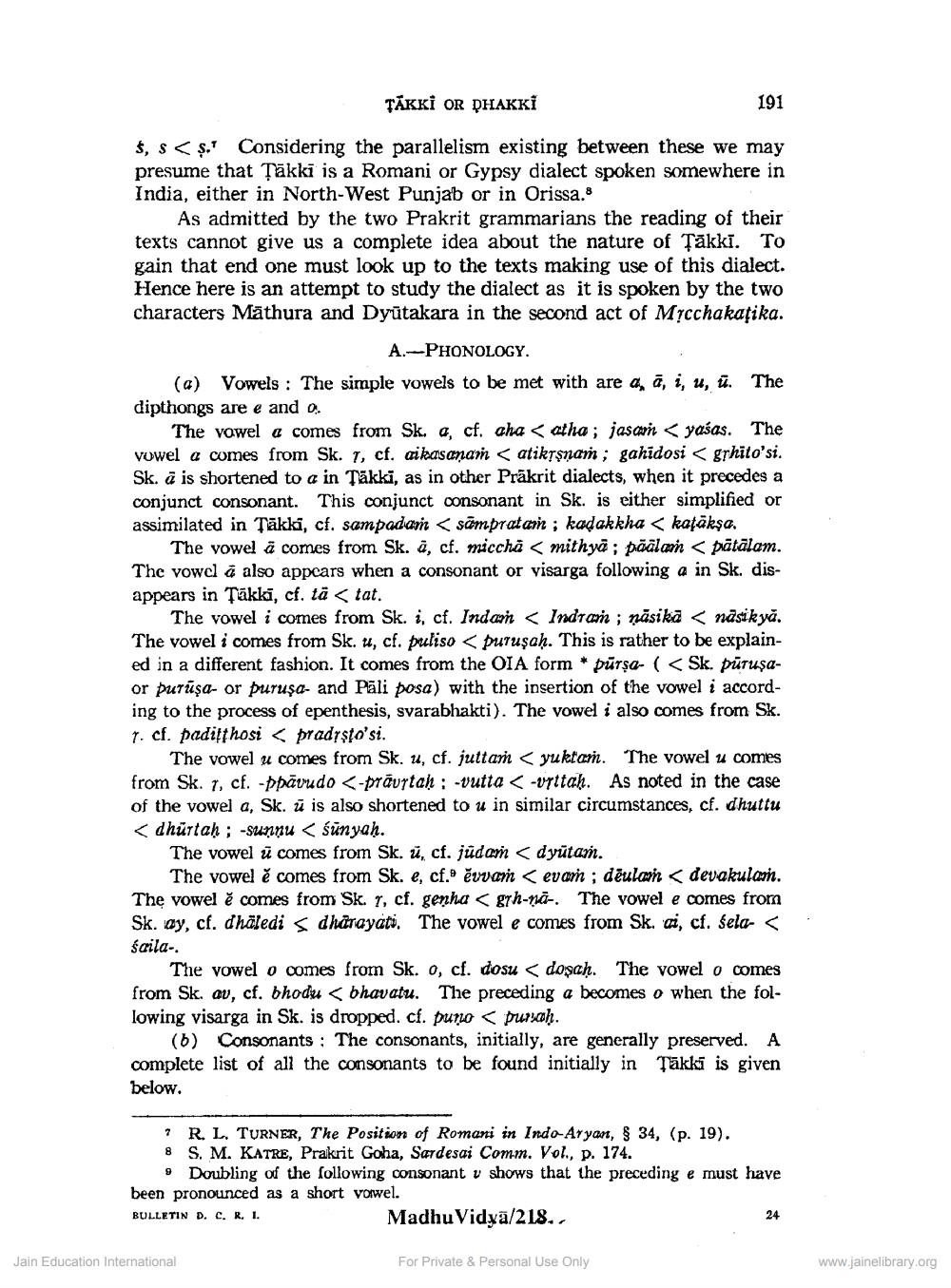________________
TAKKI OR DHAKKI
191
s, s<. Considering the parallelism existing between these we may presume that sākki is a Romani or Gypsy dialect spoken somewhere in India, either in North-West Punjab or in Orissa.8
As admitted by the two Prakrit grammarians the reading of their texts cannot give us a complete idea about the nature of Tākki. To gain that end one must look up to the texts making use of this dialect. Hence here is an attempt to study the dialect as it is spoken by the two characters Māthura and Dyūtakara in the second act of Mịcchakaţika.
A.-PHONOLOGY. (a) Vowels : The simple vowels to be met with are an ā, i, u, ū. The dipthongs are e and o..
The vowel a comes from Sk. a, cf. aha < atha; jasan yaśas. The vowel a comes from Sk. 1, cf. aikasanam <atiktsnam; gahidosi < grhito'si. Sk. ā is shortened to a in Täkki, as in other Prakrit dialects, when it precedes a conjunct consonant. This conjunct consonant in Sk. is either simplified or assimilated in Tākkā, cf. sampadan <sāmpratan; kadakkha <katākşa.
The vowel à comes from Sk. ,, cf. miccha < mithyā; pāälan <pātālam. The vowel à also appears when a consonant or visarga following a in Sk. disappears in Takki, cf, tā <tat.
The vowel i comes from Sk. 1, cf. Indan < Indran ; nāsika < násikyā. The vowel i comes from Sk. u, cf. puliso< puruṣaḥ. This is rather to be explained in a different fashion. It comes from the OIA form * pürşa- ( < Sk. pūtusaor puruşa- or purusa- and Pali posa) with the insertion of the vowel i according to the process of epenthesis, svarabhakti). The vowel i also comes from Sk. 1. cf. padiffhosi < pradysto'si.
The vowel u comes from Sk. u, cf. juttan < yuktam. The vowel u comes from Sk. 1, cf. - pāvudo <-prāvstah ; -vutta< -vrttah. As noted in the case of the vowel a, Sk. ū is also shortened to u in similar circumstances, cf. dhuttu < dhütah ; -sunnu < śünyaḥ.
The vowel ü comes from Sk. ū, cf. judan < dyütam.
The vowel ě comes from Sk. e, cf. évvan <evar ; dēulamh < devakula. The vowel ě comes from Sk. 1, cf. genha <gyh-na-. The vowel e comes from Sk. ay, cf. dhäledi s dharayati. The vowel e comes from Sk. ai, cf. sela- < Ścila
The vowel o comes from Sk. 0, cf. dosu < dosah. The vowel o comes from Sk. av, cf. bhodu < bhavatu. The preceding a becomes o when the following visarga in Sk. is dropped. cf. puno purvah.
(6) Consonants : The consonants, initially, are generally preserved. A complete list of all the consonants to be found initially in Tākkā is given below.
7 R. L. TURNER, The Position of Romani in Indo-Aryan, $ 34, (p. 19). 8 S. M. KATRE, Prakrit Goha, Sardesai Comm. Vol., p. 174.
9 Doubling of the following consonant v shows that the preceding e must have been pronounced as a short voiwel. BULLETIN D. C. R. I. Madhu Vidya/218..
24
home that p. 17$ 34,
Jain Education International
For Private & Personal Use Only
www.jainelibrary.org




